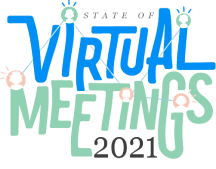Made possible by support from these great partners:







Meetings Are Eating the World
Since March 2020, the workplace has accelerated its digital transformation, and virtual meetings have been at the forefront. To what extent have our work days filled with meetings? And how has our meeting behavior evolved over the past 12 months?
We surveyed more than 500 knowledge workers to pull together quantifiable data on the state of virtual meetings today. The short answer: We spend 5x more time in meetings than we did before, and we’re still figuring out how to find our flow. See the top five highlights from the study below. For the complete list of takeaways and more data, enter your information above to download the State of Virtual Meetings 2021.
1. We spend 5x more time in meetings than we did before.
Prior to the Covid-19 pandemic, knowledge workers reported spending two hours each week in virtual meetings. Now? The average time has ballooned to 10 hours each week. Put another way, we spend one-fourth of our work week in virtual meetings via Zoom, Microsoft Teams, Google Meet, or otherwise.2. Almost 90% of us multitask during virtual meetings. We’re often checking email.
Since we’re spending more time in virtual meetings, we obviously have less time to work … or do we? Turns out that most of us are finding a way to get work done while on our calls. Almost 90% of respondents are in-meeting multitaskers. Ten percent always multitask. Seventy-four percent multitask very frequently or occasionally.
And how are we spending our multitasking time?
According to survey respondents, the most popular multitasking activity is completing work-related tasks (75 percent of multitaskers). The second most common activity is checking email. If it’s any consolation, two of the least likely activities to tempt multitaskers are social media and news.
3. Meeting fatigue is real. But so is a lack of personal connection.
In the past year, time spent in virtual meetings increased five-fold. It’s no wonder that the number one challenge of virtual meetings is meeting fatigue. One out of three respondents named “too many meetings” as the greatest challenge of this new way of working.
But a close second is the lack of a personal connection to your teammates and colleagues. One in four respondents identified that connecting with one another has proven to be quite daunting in this new in-meeting environment.
The trend magnifies when you consider virtual 1:1s. These meetings (often between a manager and a direct report) have adapted in many ways over the past 12 months with everything from 1:1 agendas, consistent scheduling, and feedback. But the biggest challenge, felt by 50 percent of 1:1 participants, is the struggle to retain a personal connection with each other.
4. Meetings are valuable. And they’re getting more productive.
Even though the rapid increase in virtual meetings was thrust upon us, we’ve mostly embraced it. Almost 93 percent of respondents say that virtual meetings are a good use of time.
And the good news continues: Three out of four respondents say that meetings are getting more productive. This new way of working is sinking in. As the saying goes, “Practice makes perfect,” and we’ve all had plenty of practice over the past several months.
5. Happy hours and all-hands aren’t the same.
With all the positivity around the virtual meeting shift, there remain a couple of meeting formats that we’ve yet to figure out. When asked about the most challenging types of virtual meetings, respondents had two clear picks: virtual happy hours and all-hands. It may be no surprise that both of these meeting types involve a large number of people. The survey also revealed that the ideal number of meeting attendees is 10 or fewer—any more and meeting productivity plummets . By nature, an all-hands meeting at a large company will far exceed the 10-person threshold, and often a virtual happy hour will, too.To see more, download the full report with all the questions, results, and takeaways.
